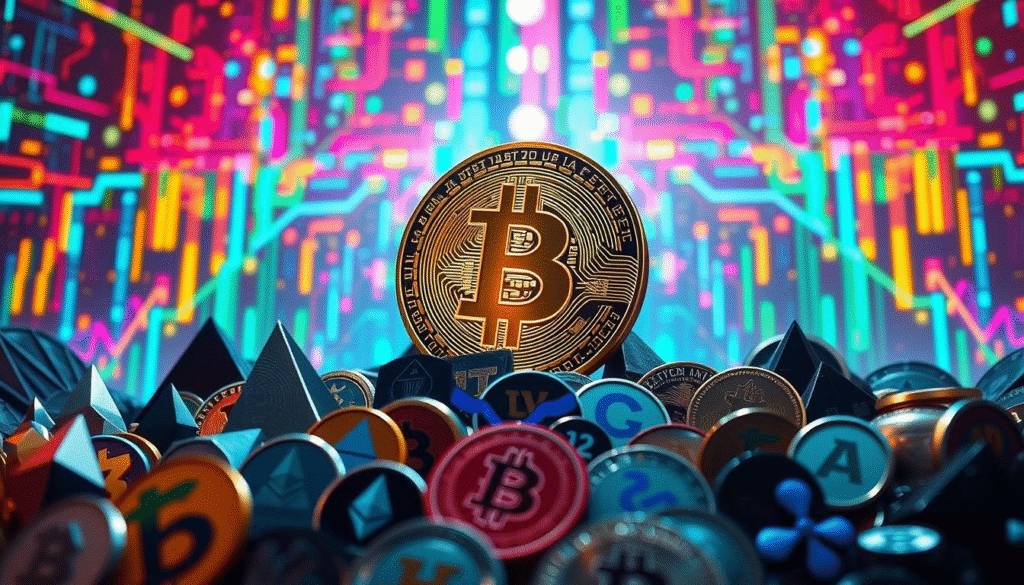The cryptocurrency market has seen a big change with the rise of digital currencies other than Bitcoin, known as altcoins. Now, with over 9,000 altcoins available, there are more chances to diversify than ever.

As blockchain tech keeps getting better, altcoins are drawing more investors. They’re looking for investment options beyond the top cryptocurrency.
It’s important to know the basics of investing in altcoins. This knowledge helps you move through this growing market.
Key Takeaways
- Altcoins offer a diverse range of investment opportunities beyond Bitcoin.
- The blockchain technology underlying altcoins is continually evolving.
- Investing in altcoins requires a solid understanding of the cryptocurrency market.
- Altcoins can provide a higher chance for returns, but also come with higher risks.
- Research and diversification are key strategies for successful altcoin investment.
What Are Altcoins and Why They Matter
Altcoins are becoming more important in the cryptocurrency world. They are not Bitcoin and serve different purposes. This includes faster transactions, smart contracts, and privacy-focused transactions.
Definition and Origin of Altcoins
Altcoins, short for alternative coins, are digital currencies not based on Bitcoin. The first altcoin, Namecoin, was launched in April 2011. Thousands of altcoins have been created, each with its own features and uses. For example, Litecoin was made to speed up Bitcoin transactions.
The start of altcoins is linked to blockchain technology. Blockchain is the tech behind Bitcoin. Altcoins have modified it for different needs, like better security or scalability.
The Growing Importance of Altcoins in the Crypto Market
Altcoins are key in the crypto market for their innovation and diversity. They give investors more choices than Bitcoin, helping to diversify portfolios. Some altcoins are made for specific tasks, like decentralized finance (DeFi) apps, which are getting popular.
Altcoins’ growing value and the blockchain project ecosystem show their importance. As the crypto market grows, altcoins will shape its future.
Recent trends suggest altcoins will lead to more innovation in digital currencies. For investors and users, knowing about altcoins is vital for understanding the changing digital currency world.
Altcoins vs. Bitcoin: Understanding the Differences
Bitcoin is well-known, but altcoins offer unique features and benefits. It’s important for investors to know these differences to diversify their portfolios.
Technical and Functional Distinctions
Altcoins stand out from Bitcoin with new tech and functions. For example, Ethereum brought smart contracts. This allows for decentralized apps and DeFi platforms. Litecoin, on the other hand, is faster than Bitcoin for transactions.

Market Behavior and Investment Potentials
Altcoins act differently in the market than Bitcoin. While Bitcoin is seen as a safe investment, altcoins are more speculative. They can offer high returns but also come with higher risks. Investors must assess each altcoin’s market value carefully.
Innovation and Use Cases
Altcoins are leading innovation in areas like finance and gaming. Some focus on privacy, while others are made for specific tasks. Their varied uses make them increasingly important in the crypto world.
| Feature | Bitcoin | Altcoins |
| Primary Use | Store of Value | Diverse (DeFi, dApps, etc.) |
| Transaction Speed | Slower | Faster (e.g., Litecoin) |
| Smart Contracts | No | Yes (e.g., Ethereum) |
Major Types of Altcoins in Today’s Market
The world of altcoins is vast and varied. They can be grouped by their uses and features. Knowing these groups helps investors and users explore the altcoin universe.
Payment and Transaction Altcoins
These altcoins focus on making transactions smoother. Litecoin and Dogecoin are examples. They aim to be faster than Bitcoin. They use blockchain technology for safety and speed.
Platform and Smart Contract Tokens
Ethereum is a key platform for smart contracts. It lets people build decentralized apps (dApps). Tokens like ERC-20 tokens are essential for these apps to work.
Utility and Service Tokens
Utility tokens unlock special services on a blockchain. For example, Filecoin tokens give access to storage. These tokens are vital for their platforms.
Stablecoins and Asset-Backed Tokens
Stablecoins keep their value steady, unlike regular coins. Tether (USDT) and USD Coin (USDC) are examples. Asset-backed tokens represent real assets, like property or gold.
Governance and DAO Tokens
Governance tokens let holders vote on blockchain projects. Maker (MKR) is one, used in MakerDAO. They help shape the project’s future.
Understanding these altcoin types is key for investors. Each has its own benefits and risks. The variety meets different needs in the crypto market, from payments to governance.

Step-by-Step Guide to Starting Your Altcoin Investment Journey
Starting in the world of altcoins can seem daunting. But with the right guide, it can be rewarding. It’s all about making informed choices.
Step 1: Educating Yourself About Blockchain Technology
Knowing about blockchain technology is key. It’s the system that keeps track of all transactions. This ensures everything is transparent and safe.
Step 2: Setting Up Secure Digital Wallets
Having a secure digital wallet is vital. Think about what kind of storage you need.
Hot Wallets vs. Cold Storage
Hot wallets are online, making things easy but risky. Cold storage is offline, which means it’s safer.
Security Best Practices
To keep your money safe, use strong passwords. Also, enable two-factor authentication and update your wallet regularly.
Step 3: Selecting and Registering with Cryptocurrency Exchanges
To trade altcoins, you need a cryptocurrency exchange. Look for one that fits your needs.
Centralized vs. Decentralized Exchanges
Centralized exchanges offer many altcoins but can be pricey. Decentralized exchanges use blockchain for direct transactions.
Verification Requirements
Exchanges usually ask for verification. You’ll need to show ID and proof of address.
By following these steps, you’re ready to start investing in altcoins. Always stay updated, keep your investments safe, and choose good exchanges.
How to Research and Select Promising Altcoins
Choosing the right altcoins from thousands available needs a smart strategy. You must deeply evaluate each project’s chances of success, not just look at surface-level numbers.
Evaluating the Project’s Fundamentals
Understanding a project’s basics is key to its success. Look at the team, the tech used, and how well it’s adopted by the community.
Team Background and Experience
The team’s history and skills are very important. Investors should seek teams with a strong background in crypto or tech. A clear vision from a transparent team is more likely to thrive.
Technology and Innovation
The tech behind an altcoin is its core. It should bring new ideas or better existing ones. Reading the whitepaper and tech docs can show its tech worth.
Community and Adoption
A big, active community shows a coin’s growth and success chances. Look for coins with a growing user base and partnerships for more adoption.
Technical Analysis for Altcoin Trading
Technical analysis is key for traders. It’s about studying price charts and trends to guess future prices. Knowing technical indicators and patterns helps make smart choices.

Red Flags to Watch Out For
When checking out altcoins, watch for red flags like lack of transparency, too-good-to-be-true promises, and weak security. Be wary of projects that seem too perfect or lack clear info.
By carefully looking at these points, investors can find their way in the complex altcoin world and spot good chances.
Essential Risk Management for Altcoin Investors
The altcoin market is very unpredictable. This makes it important for investors to use good risk management. Investing in altcoins can be very profitable, but without the right risk management, you could lose a lot.
One key strategy is to diversify your portfolio. This means spreading your investments across different altcoins. It helps lower the risk of losing money because of one asset’s ups and downs.
Portfolio Diversification Strategies
To diversify your altcoin portfolio, choose a mix of assets with different risks. You might invest in well-known altcoins with a good track record. Or, you could also put money into newer, riskier assets.
| Asset Type | Risk Level | Potential Return |
| Established Altcoins | Low-Medium | Moderate |
| Newer Altcoins | High | High |
| Stablecoins | Low | Low |
Setting Investment Limits and Stop-Losses
It’s important to set clear limits on how much you invest in each altcoin. Also, use stop-loss orders. These orders sell an asset automatically when it hits a certain price.
Peter Brandt, a veteran trader, once said, “Cut your losses short and let your winners run.” This advice is very useful in the unpredictable altcoin market.
“The biggest risk is not the one you see, but the one you don’t.”
Unknown
Managing Volatility and Market Cycles
Altcoin markets are very volatile, with prices changing a lot. It’s key to understand market cycles and be ready for downturns. This helps manage risk well.

By using a solid risk management plan, altcoin investors can handle the challenges of the crypto market better. This can lead to more success over the long term.
Exploring Decentralized Finance (DeFi) Altcoin Opportunities
The cryptocurrency market is growing, and DeFi is a big part of it. DeFi stands for Decentralized Finance. It uses blockchain technology to make finance more open and clear.
Many altcoins are important in DeFi. They offer different ways to invest, like yield farming and staking. You can also lend and borrow on these platforms.
Yield Farming and Liquidity Mining
Yield farming and liquidity mining are big in DeFi. Yield farming lets you earn rewards by adding liquidity to DeFi projects. Liquidity mining rewards you for adding liquidity to DEXs and other platforms.
Key benefits of yield farming and liquidity mining include:
- Earning passive income through liquidity provision
- Participating in the growth of DeFi ecosystems
- Diversifying investment portfolios
Staking and Earning Passive Income
Staking is a great way to earn passive income in DeFi. You lock up your assets in staking protocols. Many altcoins offer staking rewards, which are a stable income source.
| Staking Benefits | Description |
| Earning Opportunity | Generate passive income through staking rewards |
| Network Support | Help secure and validate blockchain networks |
| Flexibility | Choose from various staking protocols and altcoins |
DeFi Lending and Borrowing Platforms
DeFi lending and borrowing platforms are getting popular. They let you lend assets to earn interest or borrow for investment leverage. These platforms use smart contracts for safety and transparency.
The growth of DeFi lending and borrowing platforms shows how decentralized finance is expanding. It offers new chances for lenders and borrowers alike.
Common Mistakes New Altcoin Investors Make
The altcoin market is always changing. New investors need to watch out for common mistakes. Knowing these can help them make better choices and succeed in crypto.
Falling for Hype and FOMO
New investors often get caught up in hype and FOMO. The crypto market is very unpredictable. Prices can go up or down fast.
It’s important to be careful of unsustainable price surges caused by speculation. Doing your homework and staying calm can help avoid FOMO risks.
Ignoring Security Fundamentals
Security is key in cryptocurrency investment but often ignored. Not securing digital wallets and using weak passwords can be risky. It’s vital to use robust security measures like two-factor authentication and hardware wallets.
Lack of Strategy and Patience
New altcoin investors often lack a strategy and patience. Investing in altcoins needs a solid plan and discipline. It’s important to set realistic goals and not make quick decisions based on short-term market changes.
Having a long-term view and a diverse portfolio can help deal with the altcoin market’s ups and downs.
Conclusion: Building a Sustainable Altcoin Investment Strategy
To build a lasting altcoin investment strategy, you need to understand the crypto market well. It’s key to diversify your portfolio and manage risks. This helps you handle the challenges of altcoin investment.
Knowing the market trends and decentralized finance is vital. Learn about different altcoins like payment, platform, and utility tokens. This knowledge helps you make better investment choices.
It’s important to avoid common mistakes like getting caught up in hype. Always focus on security. A strategic and patient approach can lead to better returns and less risk.
In the end, a good altcoin investment strategy requires constant learning. Stay updated on the crypto world to succeed.
FAQ
What are altcoins, and how do they differ from Bitcoin?
Altcoins are different cryptocurrencies that came after Bitcoin. They have their own special features and uses. While Bitcoin is well-known, altcoins offer new chances for growth and variety.
What are the major types of altcoins available in the market?
Altcoins can be divided into several types. These include payment altcoins, smart contract tokens, utility tokens, stablecoins, and governance tokens. Each type has its own purpose and benefits, giving investors many options.
How do I start investing in altcoins?
To invest in altcoins, first learn about blockchain. Then, set up a safe digital wallet and join a trusted exchange. It’s important to pick promising altcoins, manage risks, and keep up with market news.
What are the key factors to consider when evaluating an altcoin project?
When looking at an altcoin project, check its basics, tech, and innovation chances. Also, watch for warning signs like unclear info, too-good-to-be-true claims, or weak security.
How can I manage risk when investing in altcoins?
To handle risks, spread out your investments, set limits, and know when to stop losses. Keep up with market changes and have a solid plan. Avoid making quick decisions based on feelings.
What are DeFi altcoins, and how can I invest in them?
DeFi altcoins are part of the decentralized finance world. They offer chances for earning, staking, and lending. To invest, learn about the project, understand the risks, and diversify your portfolio.
What are some common mistakes new altcoin investors make?
New investors often fall for hype, ignore security, and lack a plan. To avoid these, stay informed, do your homework, and have a solid strategy.
How can I stay up-to-date with the latest developments in the altcoin market?
To keep up with altcoin news, follow trusted sources like news sites, social media, and reports. Also, be aware of market trends, rule changes, and tech updates.
